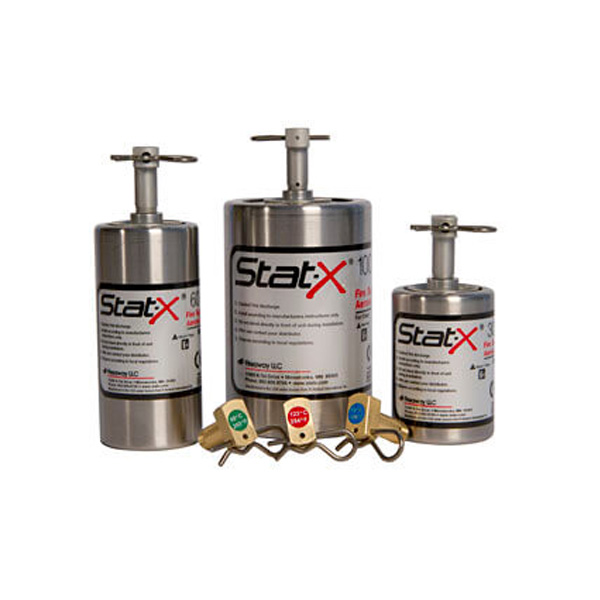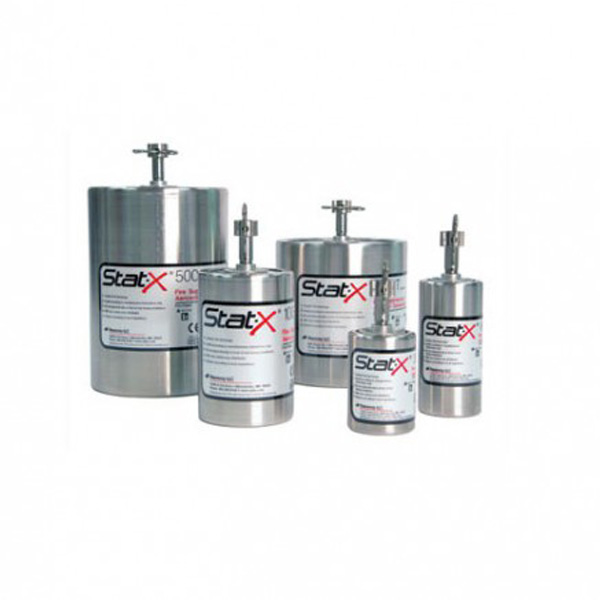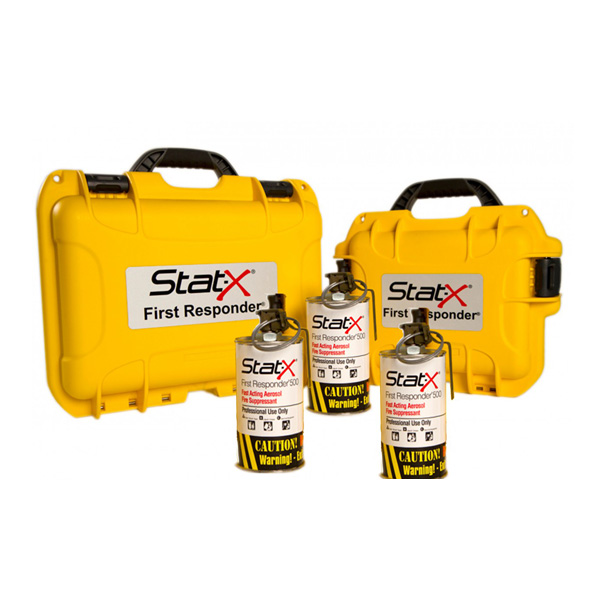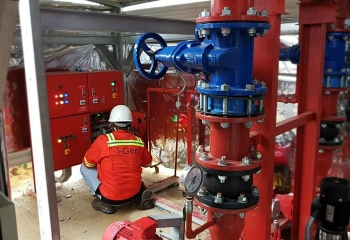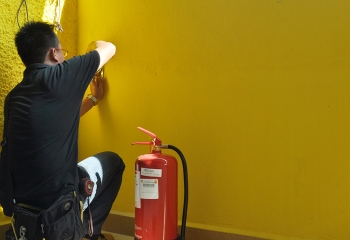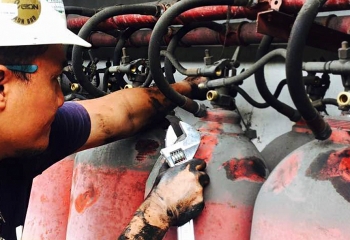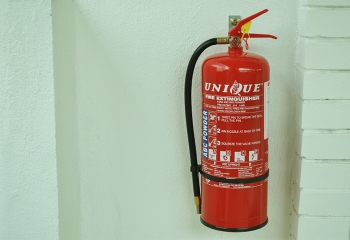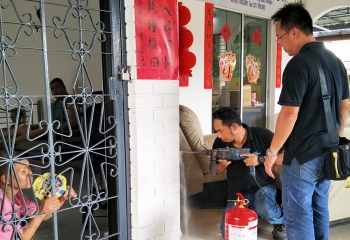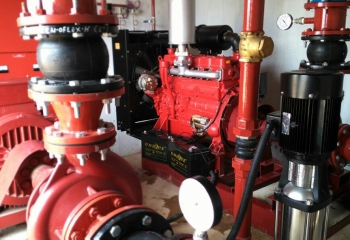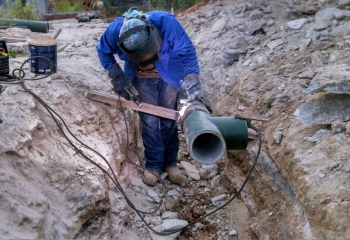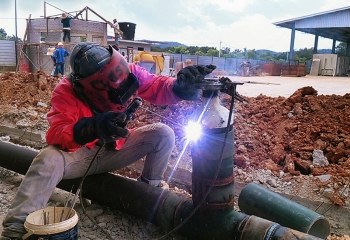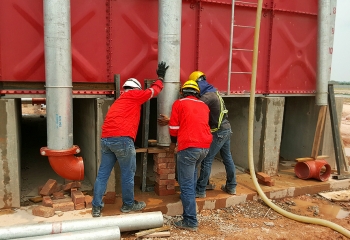Stat-X Fixed Systems: Electrical Units
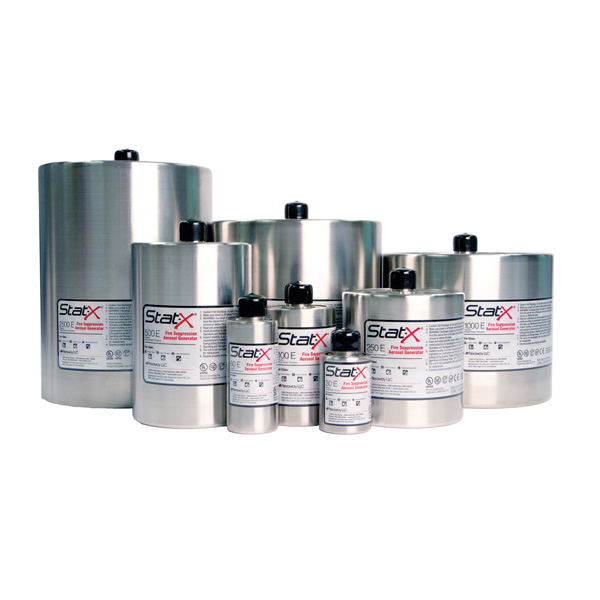

- Approved for normally-occupied spaces
- Significantly more effective than alternative extinguishing agents
- Zero ozone depletion, zero atmospheric life, and insignificant global warming potential
- Ease of installation — no pressure vessels, piping, or expensive installation manpower
- Low maintenance
- Provides reliable, cost effective protection for a wide range of fire hazards
- Listed for Class A, B, C fires by UL, ULC, CSIRO, ECB, and many others
- Favorably reviewed by EPA for SNAP listing
- Suitable for enclosed facilities and local applications
- Post fire cleanup — aerosol suspends in air for clean-up and venting after discharge
- Compact — up to a 90% reduction in space and weight requirements
- Available in the following sizes (see specifications for more details):
- — 30 E (.03 kg aerosol mass)
- — 60 E and 60 E long (.06 kg aerosol mass)
- — 100 E (.10 kg aerosol mass)
- — 250 E and 250 ME (.25 kg aerosol mass)
- — 500 E (.50 kg aerosol mass)
- — 1000 E and 1000 ME (1.00 kg aerosol mass)
- — 1500 E (1.50 kg aerosol mass)
- — 2500 E (2.50 kg aerosol mass)
Due to their fast response time, low fire extinguishing concentration, and environmental safety, Stat-X fire suppression systems may be used in critical applications across a wide range of industries. Aerosol generators are currently protecting and are suitable for use in:
- Control rooms
- Generator rooms
- Wind turbine nacelles and power rooms
- Flammable liquid storage areas
- Turbine and generator enclosures
- Marine engine rooms and machinery spaces
- Power plants
- Small boats
- Engine compartments
- Elevator machine room
- Chemical storage
- Pharmaceutical plants
- Robots
- Food processing
- High value mobile machinery
Upon detection of a fire, Stat-X generators can be activated either manually or automatically from a suitable listed releasing device. All auxiliary system components (release panel, detection, remote pull stations, etc.) are listed/approved by UL, ULC, FM, New York City MEA, and California State Fire Marshall.
Upon activation, the generators produce an exceptionally effective, ultra-fine, potassium based aerosol. Unlike gaseous systems, Stat-X aerosol generators are very cost effective to install and maintain — as they do not require the pressure vessels, piping or expensive installation costs associated with other extinguishing systems.
Space and weight requirements are minimal. On an agent weight basis, Stat-X aerosol is ten times more effective than gaseous agent alternatives.
The Stat-X generator’s effectiveness is a function of its patented design, aerosol composition, and ultra-fine particle size. Fire suppression is rapidly achieved through interference between the ultra-fine aerosol particulate and the flame’s free radicals — terminating propagation of the fire.
Stat-X aerosol generators are virtually maintenance free and have a service life of over 10 years. This, coupled to their very low installation cost, makes them an extremely cost effective fire protection solution.
Agent Container. The generator housing shall be constructed of exterior and interior stainless steel shells separated by an insulating material. Top and bottom of housing shall be stainless steel and (for electrically activated units) incorporate a 3/4″ NPT fitting to enable direct connection to conduit. Housing shall be sealed with a non-permeable membrane and shall incorporate a mechanical means to insure rupture of the membrane upon activation. Housing shall be non-pressurized prior to system activation.
Finish. Brushed Stainless Steel. Units shall have passed salt spray corrosion testing per UL Standard 2127 as part of their listing.
Aerosol Agent. Aerosol generated shall be potassium based and manufacturer shall provide fifteen (15) minute time weighted average data from an independent United States laboratory demonstrating that the aerosol does not produce (at normal design concentrations harmful levels of CO, CO2, and NOx based on NIOSH standards. Shall have no ozone depletion potential and no global warming potential. Agent shall be approved for commercial sale by the US EPA.
Listing. Aerosol generators shall be listed by Underwriter’s Laboratories of Canada to UL Standard 2127 or equivalent.
System. Extinguishing system shall be accomplished by means of distributed generating devices to insure distribution of extinguishing aerosol throughout the protected volume. Devices shall be capable of being supervised.
Mounting. Generator devices shall be mounted by means of stainless steel bracketing that allows for directional adjustment through both vertical and horizontal plane.
Operation/Storage Parameters:
- Temperature -40° C to +54° C (-40° F to +130° F)
- Relative Humidity up to 98% at +35° C (+95° F)
Transportation Classification:
- Classification Code: 4.1
- UN Identification #: UN 3178
- Packaging Group: PGIII
- Shipping Limitations:
- — Ground: None
- — Max. weight per unit packaging — Cargo Air 100 kgs (220 lbs)
- — Max. weight per unit packaging — Passenger Air 25 kgs (55 lbs)
General Specifications:
| Model | 30 E | 60 E | 60 E | 100 E | 250 E | 500 E | 1000 E | 1500 E | 2500 E | |
|---|---|---|---|---|---|---|---|---|---|---|
|
Aerosol Mass: grams |
30 | 60 | 60 | 100 | 250 | 500 | 1000 | 1500 | 2500 | |
|
Weight: kg (lbs) |
.371 (.818) |
.486 (1.08) |
.561 (1.24) |
.910 (2.0) |
2.54 (5.61) |
3.42 (7.54) |
7.16 (15.8) |
8.57 (18.9) |
11.33 (25.0) |
|
|
Length: mm (inches) |
109 (4.29) |
130 (5.12) |
155 (6.10) |
121 (4.76) |
150 (5.90) |
180 (7.09) |
170 (6.70) |
203 (7.99) |
267 (10.51) |
|
|
Diameter: mm (inches) |
51 (2.0) |
51 (2.0) |
51 (2.0) |
76 (3.0) |
127 (5.0) |
127 (5.0) |
203 (8.0) |
203 (8.0) |
203 (8.0) |
|
| Discharge Time:(sec) | 7.0 | 10.0 | 10.0 | 12.0 | 12.0 | 23.0 | 16.0 | 23.0 | 36.0 | |
| Initiation Current (Amp) | Parallel | 0.5 | 0.5 | 0.5 | 0.5 | 0.5 | 0.5 | 0.5 | 0.5 | 0.5 |
| Series | 1.0 | 1.0 | 1.0 | 1.0 | 1.0 | 1.0 | 1.0 | 1.0 | 1.0 | |
| Pulse Duration (millisecond) | 50 | 50 | 50 | 50 | 50 | 50 | 50 | 50 | 50 | |
| Max. Supervisory Current (Amp) | ≤ .005 | ≤ .005 | ≤ .005 | ≤ .005 | ≤ .005 | ≤ .005 | ≤ .005 | ≤ .005 | ≤ .005 | |
